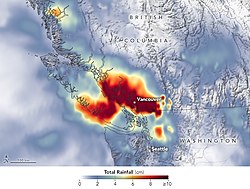 Rainfall totals throughout the Pacific Northwest on November 14. | |
| Date | November 14 - December 17, 2021 |
|---|---|
| Location | Southern British Columbia, Canada Northwestern Washington, United States |
| Cause | Successive rain systems in a Pineapple Express type of atmospheric river |
| Deaths | At least 5; 1 indirect[1] |
| Property damage | $2.5-7.5 billion[2][3][4] |
The 2021 Pacific Northwest floods were a series of floods that affected British Columbia, Canada, and parts of neighboring Washington state in the United States. The flooding and numerous mass wasting events were caused by a Pineapple Express, a type of atmospheric river, which brought heavy rain to parts of southern British Columbia and northwestern United States. The natural disaster prompted a state of emergency for the province of British Columbia.[5]
Of particular concern in southern British Columbia was the severe short-term and long-term disruption of the transportation corridor linking the coastal city of Vancouver, Canada's largest port, to the Fraser Valley, the rest of British Columbia and the rest of Canada. The Fraser Valley, which is heavily populated, is responsible for most of the agricultural production in the province, with limited ability to feed livestock in the absence of rail service.[6] The Fraser Valley was particularly hard hit, as all major routes westward to Vancouver and eastward toward Alberta were impacted. Alternative routes into northern BC and southbound into Washington state are limited by the mountainous topography. The heavily used rail links of the Canadian National Railway (CN) and Canadian Pacific Railway (CP) were both disrupted, as well as all highways that connect the Lower Mainland with the rest of the province.[7]
The British Columbia Minister of Public Safety, Mike Farnworth, issued a statement that the military deployment ended on December 17 after a month of aid. Conditions had improved enough for the reconstruction be managed by contractors, non-governmental organizations and a dedicated contingent from the region's wildland fire management service.[8]
On December 10, the Insurance Bureau of Canada announced that the flooding cost at least $CDN 450 million in insured damage, making it the costliest natural disaster in British Columbia history. However, this amount did not include damage to infrastructure and other uninsured property. In particular, in the Sumas Prairie of the Abbotsford area, more than 600,000 farm animals perished in the floods.[2] The reinsurer Aon issued a statement on December 17, 2021 claiming that the economic damage would amount to more than US$ 2 billion.[3] According to the annual report of the NGO Christian Aid, issued December 26, the damages could amount up to US$ 7.5 billion.[4]
- ^ Cite error: The named reference
CBCPawsonwas invoked but never defined (see the help page). - ^ a b "Inondations en Colombie-Britannique: au moins 450 millions $ en dommages assurées". Le Journal de Montréal (in French). Agence QMI. December 10, 2021. Retrieved December 10, 2021.
- ^ a b Rachel Dalton (December 17, 2021). "Flooding in British Columbia causes $ 2 billion in economic losses: Aon". Insurance Insider. Retrieved December 19, 2021.
- ^ a b Agence France-Presse (December 26, 2021). "Plus de 170 milliards de dollars de dommages". La Presse (in French). Retrieved December 27, 2021.
- ^ Zussman, Richard (November 17, 2021). "B.C. declares state of emergency amid record-breaking floods". globalnews.ca. Retrieved November 17, 2021.
- ^ Pratt, Sean (November 16, 2021). "B.C. flooding cuts access to Port of Vancouver". The Western Producer. Retrieved November 17, 2021.
- ^ Baker, Rafferty (November 17, 2021). "Trucking industry working to get around catastrophic B.C. highway closures". CBC News. Retrieved November 17, 2021.
- ^ "Inondations : l'armée termine son travail en Colombie-Britannique". La Presse (in French). The Canadian Press. December 18, 2021. Retrieved December 18, 2021.